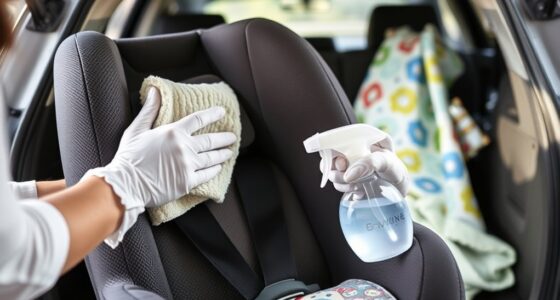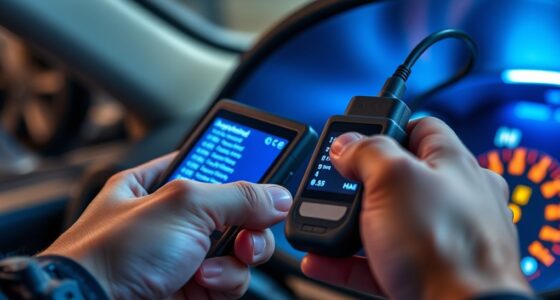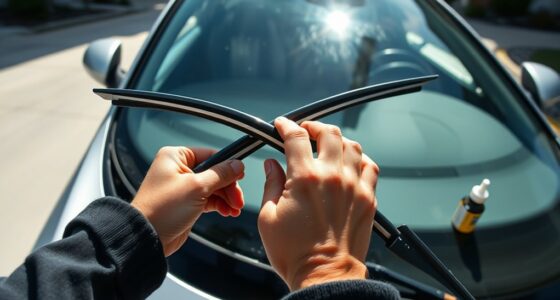If your car battery dies unexpectedly, you can safely jump-start it by first checking for signs of trouble like dim lights or slow starts. Gather proper safety gear and jumper cables, then carefully connect the cables in the correct order—positive to positive, negative to a grounded metal surface. Start the donor vehicle, let it run, and then try to start your car. Once done, disconnect everything safely and follow up with proper maintenance tips to keep your vehicle reliable—more details to help you throughout the process.
Key Takeaways
- Identify signs of a dead battery, such as difficulty starting or dim lights, before attempting a jump-start.
- Gather proper safety gear, inspect batteries, and ensure both vehicles are off and parked on a flat surface.
- Connect jumper cables correctly: positive to positive, negative to negative, and ground away from the dead battery.
- Start the donor vehicle, let it run, then attempt to start the dead vehicle; monitor for issues during charging.
- Disconnect cables safely, run the engine to recharge, and check the battery and connections for maintenance and future safety.
Understanding When Your Car Needs a Jump-Start
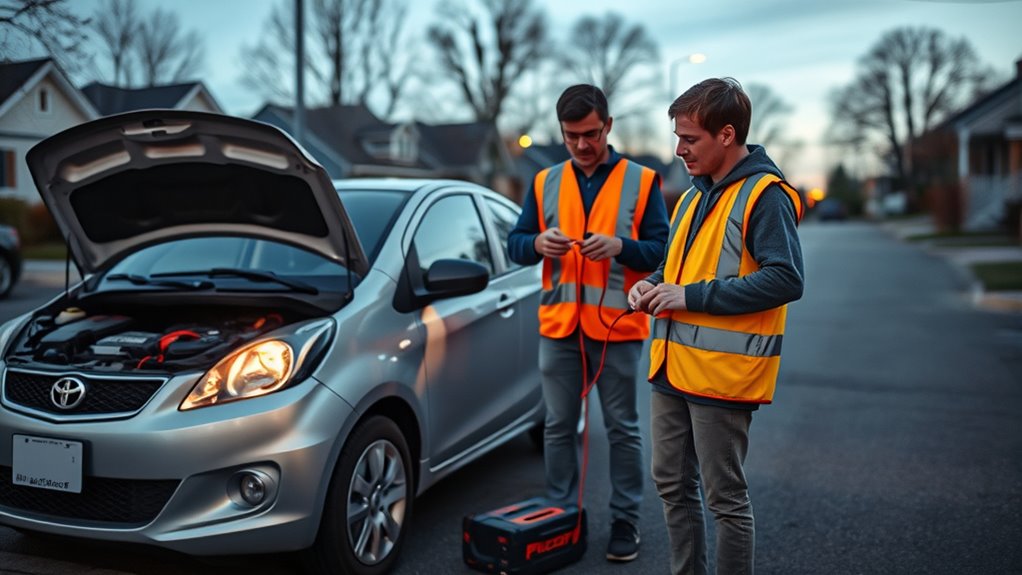
If your car’s engine struggles to start or the electrical components are dim or unresponsive, it’s likely time for a jump-start. Poor battery health is a common cause, especially if you notice frequent difficulty starting your vehicle or if the battery appears corroded or old. Your electrical system also plays a role; if it’s draining power or experiencing faults, your battery may not hold a charge. Signs include flickering lights, a dashboard warning, or a clicking sound when turning the key. Recognizing these symptoms helps prevent being stranded. Regularly checking your battery’s condition and monitoring your electrical system can save you from sudden breakdowns. When in doubt, a quick test with a multimeter or professional inspection can confirm if a jump-start is needed. Additionally, understanding the role of electrical systems can help you better diagnose underlying issues before they become serious.
Gathering the Necessary Equipment and Safety Gear
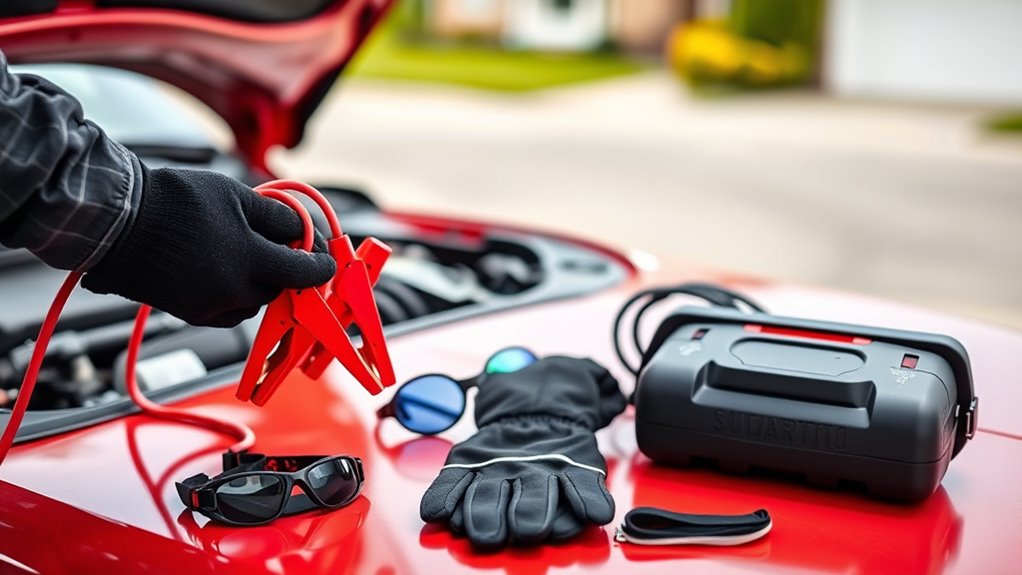
Before attempting a jump-start, gather all the necessary equipment and safety gear to guarantee a safe and efficient process. You’ll need jumper cables compatible with your vehicle’s battery type, whether it’s standard lead-acid or AGM. Check the cables for damage or corrosion before use. Safety precautions are essential: wear gloves and eye protection to guard against sparks or acid leaks. Ensure you have a fire extinguisher nearby, just in case. Keep a flashlight handy if lighting is poor. Confirm the working condition of your safety gear and understand your vehicle’s battery specifications. Proper preparation minimizes risks and streamlines the process, making sure you stay safe while jump-starting your car. Being thorough now prevents complications later. Additionally, understanding your vehicle’s battery specifications can help prevent damage during the jump-start procedure.
Preparing Your Vehicles for the Jump-Start
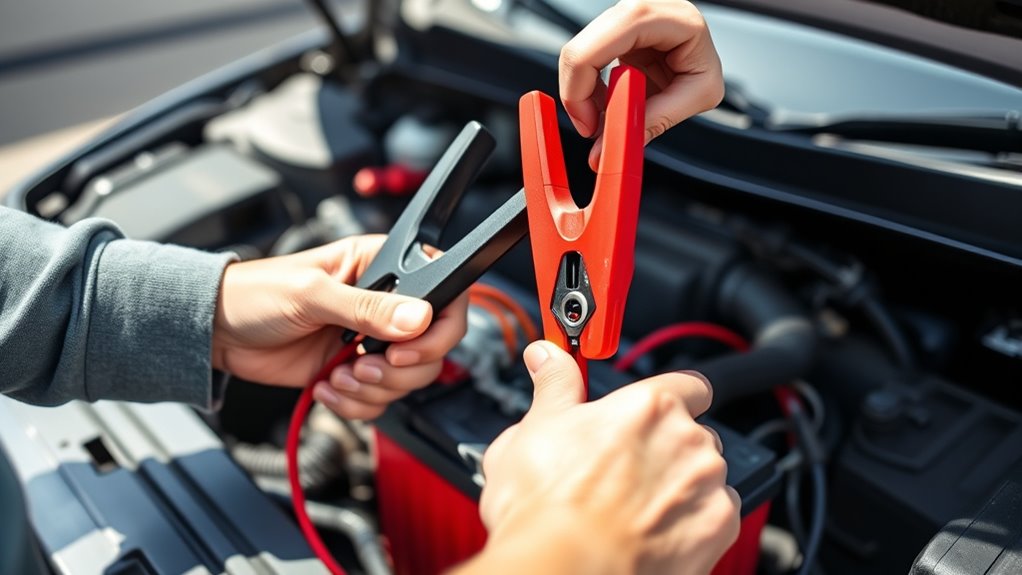
To guarantee a smooth jump-start, you need to prepare both vehicles properly. Start by inspecting each vehicle’s battery for corrosion, leaks, or damage, and clean terminals if needed. Regular battery maintenance helps ensure a reliable connection and prevents issues during jump-starting. Check that the battery is securely mounted and that there are no loose or frayed wires. Perform a quick vehicle inspection to ensure all safety features are active, such as parking brakes and turn signals. Confirm that both vehicles are in the “off” position and that the area around the batteries is clear of flammable materials. Proper preparation minimizes risks and makes the process safer and more efficient. Taking these steps ensures your vehicles are ready for a successful jump-start. Proper vehicle maintenance also plays a key role in preventing unexpected battery failures.
Connecting the Jumper Cables Correctly
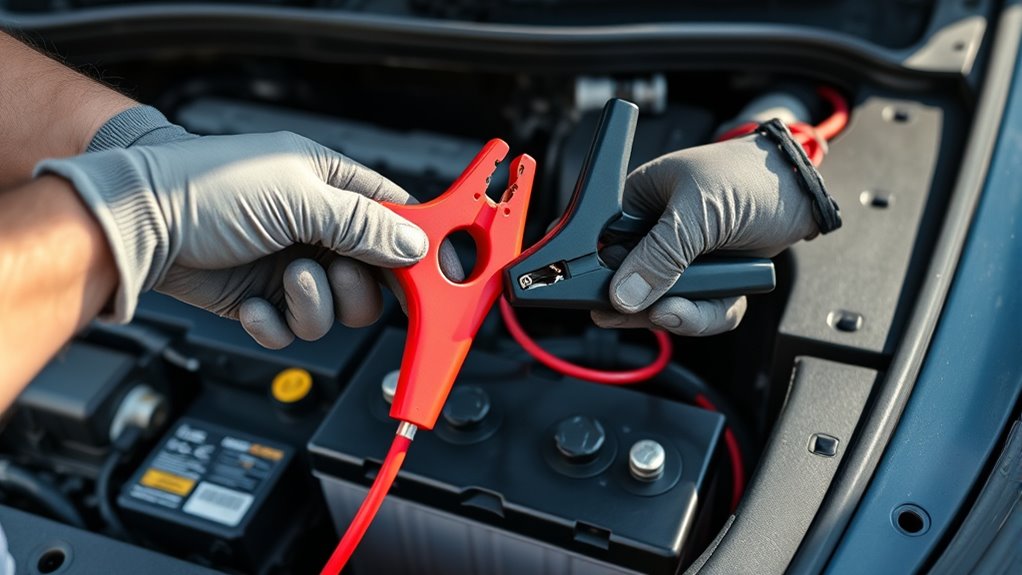
When connecting the jumper cables, make sure you place the clamps correctly on each battery terminal. Always attach the positive clamp to the positive terminal and the negative clamp to the negative terminal to avoid sparks or damage. Proper clamp placement and correct polarity connection are essential for a safe and effective jump start. Additionally, understanding digital literacy can help in troubleshooting electronic issues with modern vehicles.
Proper Clamp Placement
Proper clamp placement is essential for a safe and effective jump-start. Correct clamp placement guarantees a solid connection and minimizes the risk of sparks or damage. Always keep the clamps clear of moving parts and hot surfaces. When attaching the clamps, follow safety precautions by avoiding contact with each other or other metal objects. Double-check that the clamps are securely attached to the correct terminals. Proper clamp placement involves placing the red clamp on the positive (+) terminal of the dead battery and the other red clamp on the positive (+) terminal of the good battery. The black clamp should connect to the negative (-) terminal of the good battery, and the remaining black clamp should be grounded away from the dead battery, preferably on a metal surface. This ensures safe and reliable jump-starting.
Correct Polarity Connection
Ensuring correct polarity connection is essential to prevent damage and guarantee safety during a jump-start. Always connect the positive (red) clamp to the positive terminal of both batteries, and the negative (black) clamp to the negative terminal. Avoid polarity reversal, which occurs when the clamps are connected incorrectly, as it can cause sparks, damage your vehicle’s electrical system, or even lead to dangerous explosions. Double-check your wiring before starting the process to prevent incorrect wiring. If you accidentally connect the cables backwards, disconnect immediately and correct the connections. Taking this step seriously minimizes risks and guarantees a smooth, safe jump-start. Remember, careful attention to polarity connection is the key to avoiding costly repairs and injuries.
Starting the Donor Vehicle and Allowing the Dead Battery to Charge
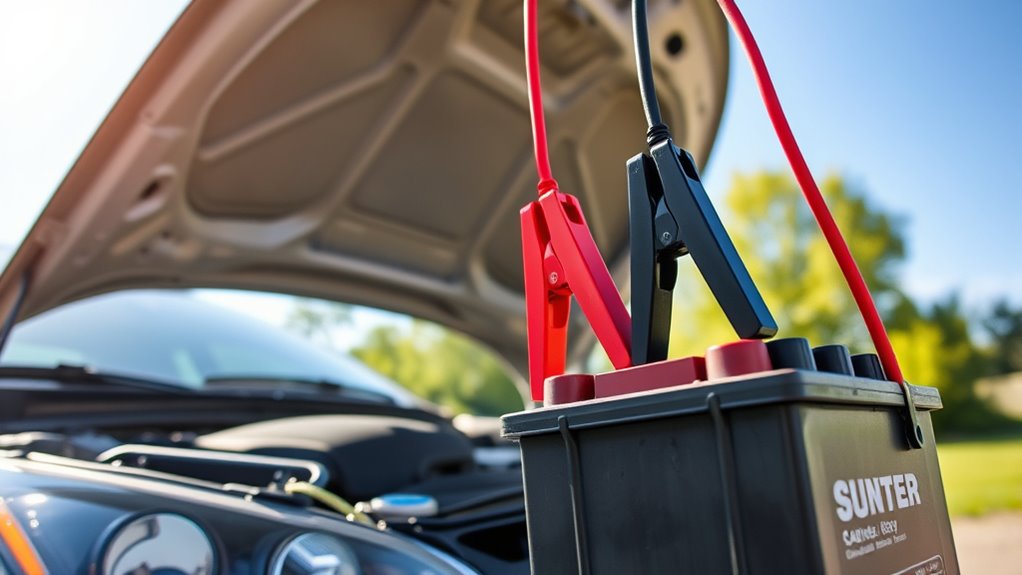
Start the donor vehicle and let it run for a few minutes to begin charging the dead battery. Keep an eye on the connection to make certain everything stays secure and proper. Once enough charge is transferred, turn off the donor vehicle before disconnecting the cables. Additionally, ensuring your workspace is ergonomically arranged can help prevent fatigue during the process.
Ensuring Proper Connection
Before connecting the jumper cables, make sure both vehicles are turned off and parked on a flat surface. Proper connection is crucial to prevent damage and guarantee safety. Verify the battery health of the donor vehicle; a weak or damaged battery might not provide enough charge. Use the appropriate jumper cable types—heavy-duty cables with insulated clamps for a secure connection. When connecting, attach the positive (red) clamp to the positive terminal of the dead battery, then to the donor battery. For the negative (black) clamp, connect it to the negative terminal of the donor vehicle and a grounded metal surface away from the dead battery. This setup helps prevent sparks and guarantees a safe, effective charging process. Double-check all connections before starting the donor vehicle. Incorporating proper mixing techniques can enhance the overall safety and efficiency of the jump-start process.
Monitoring Charging Time
Once you’ve made the proper connections, start the donor vehicle and let it run at idle. During this time, monitor the charging process carefully. The battery capacity of the dead battery influences how long it needs to charge; smaller batteries typically require less time, while larger ones may need more. Keep an eye on the charging duration—usually 5 to 15 minutes—so you don’t overcharge or damage either battery. If the dead battery shows signs of life or the vehicle starts, you can attempt to turn off the donor vehicle and try starting the car with the dead battery. Remember, patience is key; proper monitoring guarantees a safe and effective jump-start without risking damage to either battery. Additionally, being aware of small mistakes such as overcharging can prevent costly damage and ensure a successful jump-start.
Attempting to Start Your Car and Troubleshooting Common Issues
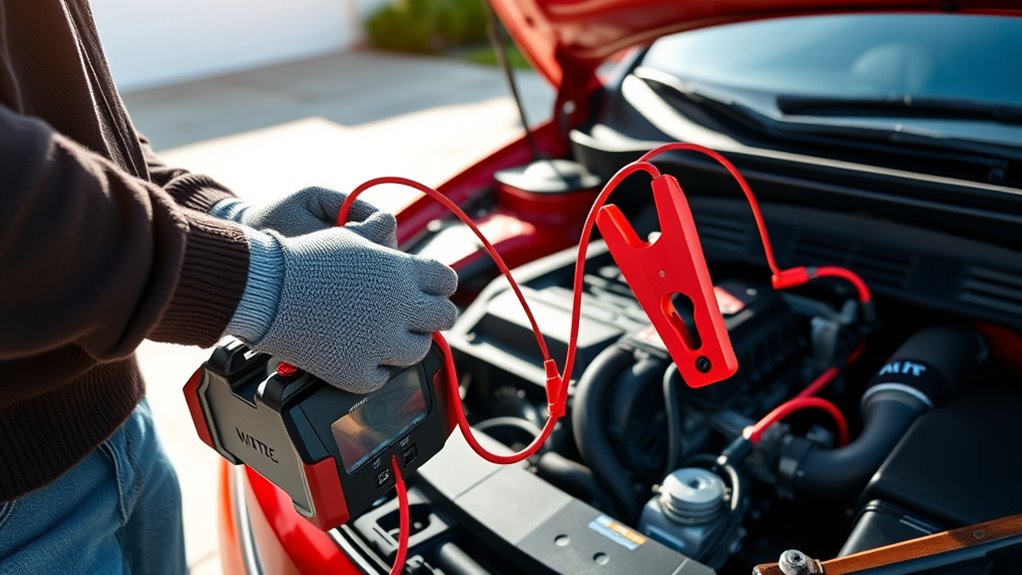
When you attempt to start your car after a jump start, it’s important to pay close attention to any signs of trouble or unusual behavior. If the engine struggles to turn over or if you notice sluggish cranking, your battery health might be compromised. Be alert for abnormal engine behavior, such as misfiring or unusual noises, which could indicate underlying issues. Troubleshooting common problems can save time and prevent damage. Consider these points:
- Slow or labored engine start
- No response or clicking sound
- Dashboard warning lights appearing
- Strange smells or smoke
- Repeated failed attempts to start
If issues persist, it may signal a deeper problem with the battery or the vehicle’s electrical system. Addressing these early helps guarantee safe and reliable operation. Additionally, persistent trust issues can sometimes manifest as electrical or mechanical problems, so it’s wise to investigate thoroughly if problems continue.
Disconnecting the Jumper Cables Safely
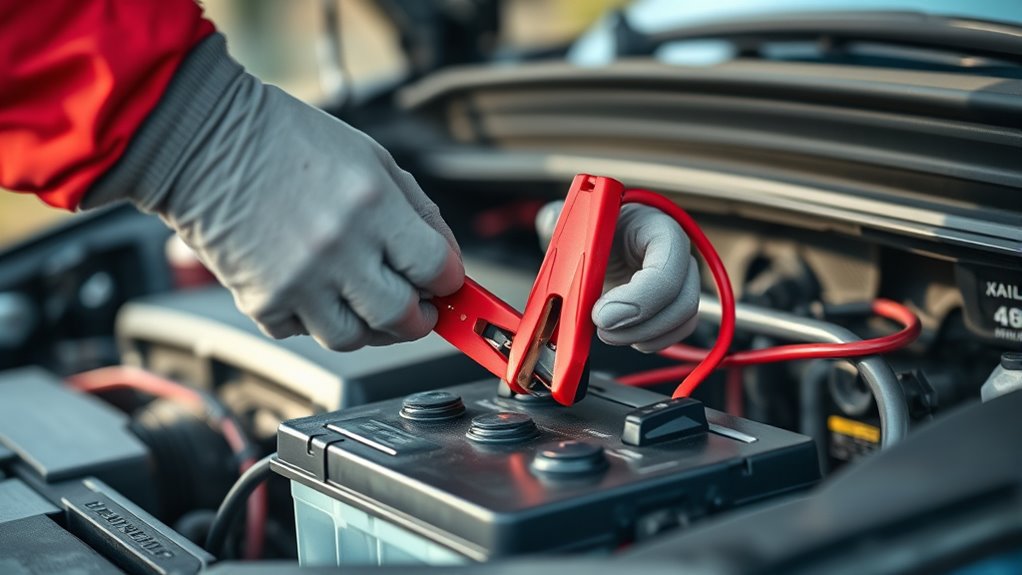
After you’ve confirmed that the engine is running smoothly and the vehicle is no longer showing signs of electrical issues, you can safely disconnect the jumper cables. Start by removing the negative (black) clamp from the grounded surface on your car first, then from the donor vehicle. Next, disconnect the positive (red) clamp from your car, followed by the donor vehicle’s positive terminal. Avoid touching the clamps together or letting them touch any metal surfaces to prevent sparks. Remember, properly disconnecting cables helps prevent damage and electrical hazards. When your battery eventually needs replacing, consider battery recycling options instead of discarding it improperly. Also, be aware of jump starting myths to avoid unsafe practices. This careful disconnection ensures both cars stay safe and ready for future use.
Post-Jump Procedures and Battery Maintenance Tips
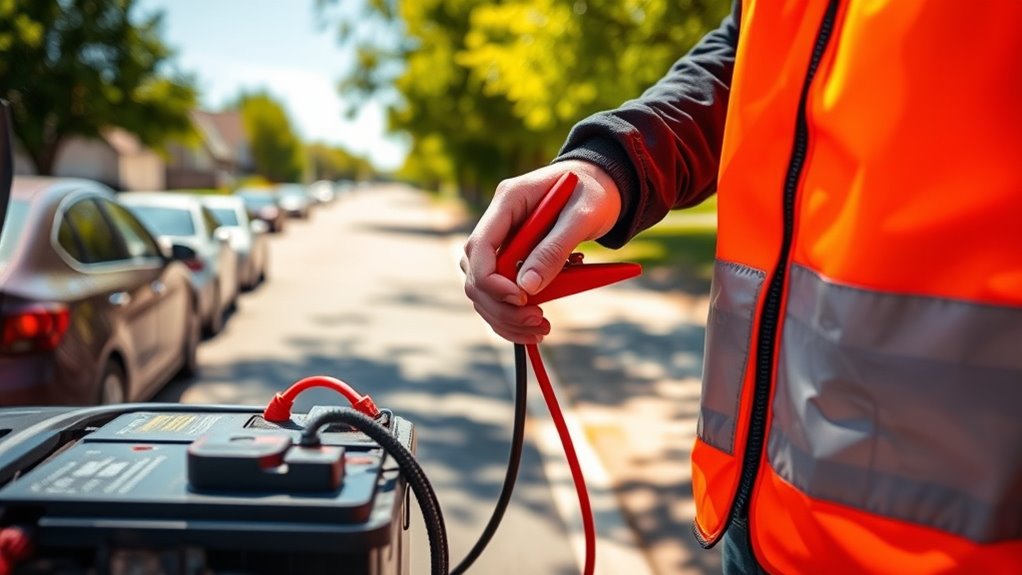
To guarantee your vehicle remains reliable after a jump start, it’s important to follow proper post-jump procedures and maintain your battery regularly. First, let the engine run for at least 15-30 minutes to recharge the battery. Then, perform a battery testing to assess its health and ensure it can hold a charge. To prevent corrosion, inspect the battery terminals and clean any build-up with a mixture of baking soda and water. Additionally, check for loose or damaged connections and tighten or replace them as needed. Regular maintenance includes applying a protective coating to terminals and ensuring the battery is securely mounted. Keep an eye out for signs of corrosion and replace the battery if it shows persistent issues, ensuring your vehicle’s reliability and safety. Monitoring your battery’s health is especially important given AI-driven diagnostics advancements that can help detect early signs of failure.
When to Seek Professional Assistance
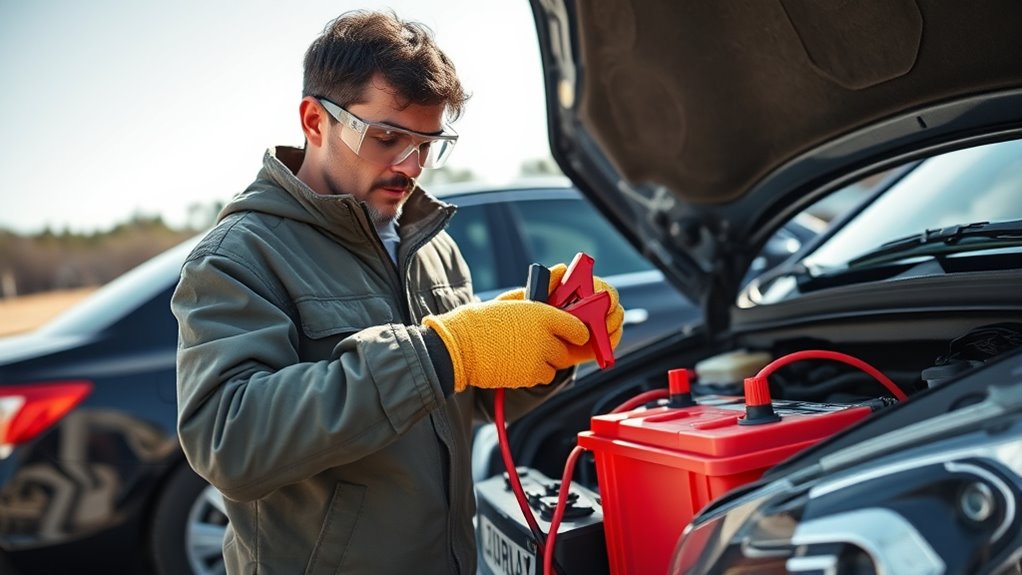
Knowing the signs of a failing or problematic battery can help you decide when it’s time to seek professional assistance. If you notice frequent battery corrosion, slow engine cranking, or dimming headlights, don’t ignore these issues. Additionally, if your car stalls unexpectedly or the battery warning light stays on, it may indicate alternator failure. These problems often require expert diagnosis and repair. Regular maintenance, such as checking for battery corrosion, can prevent further damage and ensure your vehicle’s reliability.
Frequently Asked Questions
Can Jump-Starting Damage My Car’s Electrical System?
Jump-starting your car can potentially cause battery damage or harm your electrical system if you’re not careful. If you connect the cables incorrectly or use the wrong voltage, it could lead to electrical surges or damage. However, following proper safety steps minimizes this risk. Always double-check your connections, use the correct equipment, and make sure both cars are off before starting. This way, you protect your vehicle’s electrical system from harm.
What Are Common Mistakes to Avoid During a Jump-Start?
You should avoid common mistakes like making improper connections, which can harm your battery safety. Always verify you connect the positive cable to the positive terminal and the negative to a grounded metal surface. Never connect the negative cable directly to the dead battery’s negative terminal, as it can cause sparks. Double-check your connections before starting, and avoid rushing to prevent electrical issues or damage to your vehicle.
How Long Should I Let the Dead Battery Charge?
Imagine the dead battery as a dried-out sponge, waiting to soak up life again. You should let it charge for about 5 to 15 minutes, depending on its capacity, to transfer enough energy. This allows the battery to regain some power before attempting to start the engine. Be patient, watch the gauges, and guarantee the charger stays connected until you see a steady, healthy voltage, signaling it’s ready.
Is It Safe to Jump-Start in Cold or Hot Weather?
Jump-starting in cold or hot weather can be safe if you take proper precautions. Cold temperatures may slow battery chemical reactions, so verify the battery is thoroughly charged and connections are secure. Hot weather can increase the risk of overheating or battery damage, so avoid prolonged attempts. Always follow weather safety tips, such as working in a shaded area in heat or protecting your hands from cold, and proceed carefully to prevent accidents.
Can I Jump-Start a Hybrid or Electric Vehicle?
Jump-starting a hybrid or electric vehicle isn’t a walk in the park. You need to be cautious because hybrid safety and electric vehicle risks are real. Never connect jumper cables to high-voltage parts or batteries; always follow the manufacturer’s instructions. Use a booster pack designed for hybrids or EVs, and avoid traditional jump-start methods. When in doubt, call a professional—better safe than sorry.
Conclusion
Jump-starting your car is straightforward when you follow the right steps—just remember to stay safe and patient. Did you know that over 80% of battery failures are preventable with regular maintenance? By keeping an eye on your battery’s health and knowing how to jump-start properly, you can avoid roadside surprises. Stay prepared, and you’ll keep your vehicle running smoothly without needing professional help every time. Safe driving!


